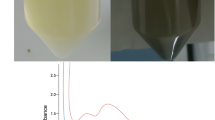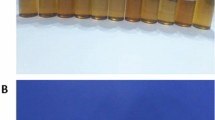Abstract
Hospital-acquired infections involving carbapenem-resistant Acinetobacter baumannii (A. baumannii) and extended spectrum beta-lactamase (ESBL)-producing Enterobacteriaceae pose significant challenges in the intensive care units. The lack of novel antimicrobial drugs amplifies the urgency to explore innovative management strategies. Nanotechnology, with its ability to generate nanoparticles possessing specific properties beneficial in drug delivery and nanomedicine, stands as a pivotal research domain. The objective of this study was to synthesize, for the first time, biologically silver nanoparticles (Ag-NPs) from Lavandula mairei Humbert (L. mairei) plant. The biosynthesized Ag-NPs were characterized by UV–visible spectral analysis, X-Ray diffraction Analysis, Fourier transform infrared spectroscopy analysis, scanning electron microscopy (SEM), and energy-dispersive X-ray spectroscopy. Subsequently, the antibacterial and antioxidant activities of Ag-NPs were assessed using the micro-dilution method, DPPH test and FRAP assay, respectively. The green-synthesized Ag-NPs exhibited high antibacterial activity against ESBL-producing multidrug-resistant (MDR) strains and against carbapenem-resistant and non-carbapenem-resistant strains of A. baumannii, as well as a very interesting antioxidant activity. The present study suggests that these results hold very promising for the potential application of biologically synthesized Ag-NPs from L. mairei (Ag-LM-NPs) in the invention of novel antibacterial and antioxidant agents.





Similar content being viewed by others
Code Availability
Not applicable.
References
Goossens H, Ferech M, Stichele RV, Elseviers M (2005) Outpatient antibiotic use in Europe and association with resistance: a cross-national database study. The Lancet 365:579–587. https://doi.org/10.1016/S0140-6736(05)17907-0
Alexander HK, MacLean RC (2020) Stochastic bacterial population dynamics restrict the establishment of antibiotic resistance from single cells. Proc Natl Acad Sci 117:19455–19464. https://doi.org/10.1073/pnas.1919672117
Ansari MA, Khan HM, Khan AA et al (2014) Antibiofilm efficacy of silver nanoparticles against biofilm of extended spectrum β-lactamase isolates of Escherichia coli and Klebsiella pneumoniae. Appl Nanosci 4:859–868. https://doi.org/10.1007/s13204-013-0266-1
Elkheloui R, Laktib A, Mimouni R et al (2020) Acinetobacter baumannii Biofilm: Intervening Factors, Persistence, Drug Resistance and Strategies of Treatment. Mediterranean J Infection, Microbes and Antimicrobials. https://doi.org/10.4274/mjima.galenos.2020.2020.7
Haque A, Yoshizumi A, Saga T et al (2014) ESBL-producing enterobacteriaceae in environmental water in Dhaka, Bangladesh. J Infect Chemother 20:735–737. https://doi.org/10.1016/j.jiac.2014.07.003
Laktib A, Nayme K, Hamdaoui AE et al (2022) Antibacterial activity of Lavandula mairei Humbert essential oil against carbapenem- resistant Acinetobacter baumannii. Mediterranean J Infection, Microbes and Antimicrobials. https://doi.org/10.4274/mjima.galenos.2021.2021.3
Romero L, López L, Rodríguez-Baño J et al (2005) Long-term study of the frequency of escherichia coli and klebsiella pneumoniae isolates producing extended-spectrum β-lactamases. Clin Microbiol Infect 11:625–631. https://doi.org/10.1111/j.1469-0691.2005.01194.x
Laktib A, Hassi M, Hamadi F et al (2018) Identification and antibiotic resistance of nosocomial bacteria isolated from the hospital environment of two intensive care units. Moroccan J Biol 15:24–41
Zarrilli R, Giannouli M, Tomasone F et al (2009) Carbapenem resistance in Acinetobacter baumannii: the molecular epidemic features of an emerging problem in health care facilities. J Infect Dev Ctries 3:335–341. https://doi.org/10.3855/jidc.240
Tiwari V, Kapil A, Moganty RR (2012) Carbapenem-hydrolyzing oxacillinase in high resistant strains of acinetobacter baumannii isolated from India. Microb Pathog 53:81–86. https://doi.org/10.1016/j.micpath.2012.05.004
Gordon O, Vig Slenters T, Brunetto PS et al (2010) Silver coordination polymers for prevention of implant infection : thiol interaction, impact on respiratory chain enzymes, and hydroxyl radical induction. Antimicrob Agents Chemother 54:4208–4218. https://doi.org/10.1128/AAC.01830-09
Lara HH, Ayala-Núñez NV, Ixtepan Turrent LD, Rodríguez PC (2010) Bactericidal effect of silver nanoparticles against multidrug-resistant bacteria. World J Microbiol Biotechnol 26:615–621. https://doi.org/10.1007/s11274-009-0211-3
Genc N (2021) Biosynthesis of silver nanoparticles using Origanum onites extract and investigation of their antioxidant activity. Part Sci Technol 39:562–568. https://doi.org/10.1080/02726351.2020.1786868
Mickymaray, (2019) One-step synthesis of silver nanoparticles using saudi arabian desert seasonal plant sisymbrium irio and antibacterial activity against multidrug-resistant bacterial strains. Biomolecules 9:662. https://doi.org/10.3390/biom9110662
Al Sufyani NM, Hussien NA, Hawsawi YM (2019) Characterization and anticancer potential of silver nanoparticles biosynthesized from Olea chrysophylla and Lavandula dentata leaf extracts on hct116 colon cancer cells. J Nanomater 2019:1–9. https://doi.org/10.1155/2019/7361695
Ramzan M, Karobari MI, Heboyan A et al (2022) Synthesis of silver nanoparticles from extracts of wild ginger (Zingiber zerumbet) with antibacterial activity against selective multidrug resistant oral bacteria. Molecules 27:2007. https://doi.org/10.3390/molecules27062007
Konappa N, Udayashankar AC, Dhamodaran N et al (2021) Ameliorated antibacterial and antioxidant properties by trichoderma harzianum mediated green synthesis of silver nanoparticles. Biomolecules 11:535. https://doi.org/10.3390/biom11040535
Huq MdA, Ashrafudoulla Md, Rahman MM et al (2022) Green synthesis and potential antibacterial applications of bioactive silver nanoparticles: a review. Polymers 14:742. https://doi.org/10.3390/polym14040742
Bindhu MR, Umadevi M (2015) Antibacterial and catalytic activities of green synthesized silver nanoparticles. Spectrochim Acta Part A Mol Biomol Spectrosc 135:373–378. https://doi.org/10.1016/j.saa.2014.07.045
Baran A, Baran MF, Keskin C et al (2021) Ecofriendly/Rapid synthesis of silver nanoparticles using extract of waste parts of artichoke (Cynara scolymus L.) and evaluation of their cytotoxic and antibacterial activities. J Nanomater 2021:1–10. https://doi.org/10.1155/2021/2270472
Ahmed MJ, Murtaza G, Rashid F, Iqbal J (2019) Eco-friendly green synthesis of silver nanoparticles and their potential applications as antioxidant and anticancer agents. Drug Dev Ind Pharm 45:1682–1694. https://doi.org/10.1080/03639045.2019.1656224
El Hamdaoui A, Msanda F, Boubaker H et al (2018) Essential oil composition, antioxidant and antibacterial activities of wild and cultivated Lavandula mairei Humbert. Biochem Syst Ecol 76:1–7. https://doi.org/10.1016/j.bse.2017.11.004
Qais FA, Shafiq A, Ahmad I et al (2020) Green synthesis of silver nanoparticles using Carum copticum: assessment of its quorum sensing and biofilm inhibitory potential against gram negative bacterial pathogens. Microb Pathog 144:104172. https://doi.org/10.1016/j.micpath.2020.104172
Ganesan P, Kumar CS, Bhaskar N (2008) Antioxidant properties of methanol extract and its solvent fractions obtained from selected Indian red seaweeds. Biores Technol 99:2717–2723. https://doi.org/10.1016/j.biortech.2007.07.005
Duan X-J, Zhang W-W, Li X-M, Wang B-G (2006) Evaluation of antioxidant property of extract and fractions obtained from a red alga, Polysiphonia urceolata. Food Chem 95:37–43. https://doi.org/10.1016/j.foodchem.2004.12.015
Chandini SK, Ganesan P, Bhaskar N (2008) In vitro antioxidant activities of three selected brown seaweeds of India. Food Chem 107:707–713. https://doi.org/10.1016/j.foodchem.2007.08.081
Mahmoudi R, Aghaei S, Salehpour Z et al (2020) Antibacterial and antioxidant properties of phyto-synthesized silver nanoparticles using Lavandula stoechas extract. Appl Organometallic Chem. https://doi.org/10.1002/aoc.5394
Villalpando M, Gómez-Hurtado MA, Rosas G, Saavedra-Molina A (2022) Ag nanoparticles synthesized using Lavandula angustifolia and their cytotoxic evaluation in yeast. Mater Today Commun 31:103633. https://doi.org/10.1016/j.mtcomm.2022.103633
Nayak S, Bhat MP, Udayashankar AC et al (2020) Biosynthesis and characterization of Dillenia indica-mediated silver nanoparticles and their biological activity. Appl Organometallic Chem. https://doi.org/10.1002/aoc.5567
Hasanin MS, Emam M, Soliman MMH et al (2022) Green silver nanoparticles based on Lavandula coronopifolia aerial parts extract against mycotic mastitis in cattle. Biocatal Agric Biotechnol 42:102350. https://doi.org/10.1016/j.bcab.2022.102350
Diantoro M, Suprayogi T, Sa’adah U, et al (2018) Modification of Electrical Properties of Silver Nanoparticle. IntechOpen J. https://doi.org/10.5772/intechopen.75682
Kong Y, Paray BA, Al-Sadoon MK, Fahad Albeshr M (2021) Novel green synthesis, chemical characterization, toxicity, colorectal carcinoma, antioxidant, anti-diabetic, and anticholinergic properties of silver nanoparticles: a chemopharmacological study. Arab J Chem 14:103193. https://doi.org/10.1016/j.arabjc.2021.103193
Mohammadi SS, Ghasemi N, Ramezani M, Khaghan S (2021) Biosynthesis of silver nanoparticles using the Falcaria Vulgaris (Alisma Plantago-Aquatica L.) extract and optimum synthesis. Chem Methodol. https://doi.org/10.22034/chemm.2021.130725
Jassal V, Shanker U, Gahlot S et al (2016) Sapindus mukorossi mediated green synthesis of some manganese oxide nanoparticles interaction with aromatic amines. Appl Phys A 122:1–12. https://doi.org/10.1007/s00339-016-9777-4
Mochalov K, Solovyeva D, Chistyakov A et al (2016) Silver nanoparticles strongly affect the properties of bacteriorhodopsin, a photosensitive protein of halobacterium salinarium purple membranes. Mater Today: Procee 3:502–506. https://doi.org/10.1016/j.matpr.2016.01.081
Popescu C-M, Vasile C, Popescu M-C et al (2006) Analytical methods for lignin characterizatioN. II spectroscopic studies. Cellulose Chem Technol 40:597–622
Stackebrandt E, Mondotte JA, Fazio LL et al (2021) Authors need to be prudent when assigning names to microbial isolates. Curr Microbiol 78:4005–4008. https://doi.org/10.1007/s00284-021-02678-4
Wintachai P, Paosen S, Yupanqui CT, Voravuthikunchai SP (2019) Silver nanoparticles synthesized with Eucalyptus critriodora ethanol leaf extract stimulate antibacterial activity against clinically multidrug-resistant Acinetobacter baumannii isolated from pneumonia patients. Microb Pathog 126:245–257. https://doi.org/10.1016/j.micpath.2018.11.018
Danaei M, Motaghi MM, Naghmachi M et al (2021) Green synthesis of silver nanoparticles (AgNPs) by filamentous algae extract: comprehensive evaluation of antimicrobial and anti-biofilm effects against nosocomial pathogens. Biologia 76:3057–3069. https://doi.org/10.1007/s11756-021-00808-8
Khan N, Khan I, Nadhman A et al (2020) Pinus wallichiana -synthesized silver nanoparticles as biomedical agents: in-vitro and in-vivo approach. Green Chem Lett Rev 13:69–82. https://doi.org/10.1080/17518253.2020.1733105
Shah AA, Ahmad I, Shafique M et al (2022) Antibacterial activity of silver nanoparticles against carbapenem-resistant Acinetobacter baumannii clinical isolates. Pakistan J Pharm Sci 35:203–208. https://doi.org/10.36721/PJPS.2022.35.1.SUP.203-208.1
Alzahrani S, Ali HM, Althubaiti EH, Ahmed MM (2022) Green synthesis of gold nanoparticles, silver nanoparticles and gold-silver alloy nanoparticles using ziziphus spina-christi leaf extracts and antibacterial activity against multidrug-resistant bacteria. Indian J Pharm Sci. https://doi.org/10.36468/pharmaceutical-sciences.spl.490
Banu A, Rathod V, Ranganath E (2011) Silver nanoparticle production by Rhizopus stolonifer and its antibacterial activity against extended spectrum β-lactamase producing (ESBL) strains of enterobacteriaceae. Mater Res Bull 46:1417–1423. https://doi.org/10.1016/j.materresbull.2011.05.008
Vamanu E, Ene M, Biță B et al (2018) In vitro human microbiota response to exposure to silver nanoparticles biosynthesized with mushroom extract. Nutrients 10:607. https://doi.org/10.3390/nu10050607
Edhari BA, Mashreghi M, Makhdoumi A, Darroudi M (2021) Antibacterial and antibiofilm efficacy of Ag NPs, Ni NPs and Al2O3 NPs singly and in combination against multidrug-resistant Klebsiella pneumoniae isolates. J Trace Elem Med Biol 68:126840. https://doi.org/10.1016/j.jtemb.2021.126840
Singh M, Singh S, Prasad S, Gambhir IS (2008) Nanotechnology in medicine and antibacterial effect of silver nanoparticles. Digest J Nanomater Biostructure 3:115–122
Matthäus B (2002) Antioxidant activity of extracts obtained from residues of different oilseeds. J Agric Food Chem 50:3444–3452. https://doi.org/10.1021/jf011440s
Odemis O, Ozdemir S, Gonca S, Agirtas MS (2022) Characterization of silver nanoparticles fabricated by green synthesis using urtica dioica and lavandula angustifolia and investigation of antimicrobial and antioxidant. Inorganic and Nano-Metal Chem. https://doi.org/10.1080/24701556.2022.2068584
Aruna A, Nandhini SR, Karthikeyan V, Bose P (2014) Comparative in-vitro antioxidant screening of methanolic extract of costus pictus & its silver nanoparticles. Int J Pharm Sci Drug Res 6:334–340
Funding
This work was supported by the Moroccan National center of scientific and technical research (VPMA3; n°: 576/2021), the National Agency for Medicinal and Aromatic Plants, and the Ministry of National Education, Vocational Training, Higher Education, and Scientific Research.
Author information
Authors and Affiliations
Contributions
Soufiane El megdar contributed to writing of the original draft, writing, reviewing, & editing of the manuscript, methodology, and results analysis; Lahbib Fayzi contributed to methodology and plant extraction; Raja Elkheloui contributed to methodology and writing, reviewing, & editing of the manuscript; Asma Laktib contributed to isolation and identification of bacterial strains; Mohamed Bourouache contributed to statistical analysis; Abdellah El boulani contributed to results analysis; Hicham Abou oualid contributed to visualization and correction; Khalil Cherifi contributed to review and correction of paper; Fouad Msanda contributed to collection and identification of plant; Hassi Mohamed contributed to review and correction of paper; Rachida Mimouni contributed to writing, reviewing, & editing of the manuscript, methodology, and results analysis. Fatima Hamadi contributed to writing of the original draft, writing, reviewing, & editing of the manuscript, methodology, and results analysis.
Corresponding author
Ethics declarations
Conflict of interest
The authors have no conflicts of interest.
Ethical Approval
Not applicable.
Consent to Participate
Not applicable.
Consent for Publication
Not applicable.
Additional information
Publisher's Note
Springer Nature remains neutral with regard to jurisdictional claims in published maps and institutional affiliations.
Rights and permissions
Springer Nature or its licensor (e.g. a society or other partner) holds exclusive rights to this article under a publishing agreement with the author(s) or other rightsholder(s); author self-archiving of the accepted manuscript version of this article is solely governed by the terms of such publishing agreement and applicable law.
About this article
Cite this article
EL Megdar, S., Fayzi, L., Elkheloui, R. et al. Biological Synthesis of Silver Nanoparticles from Lavandula mairei Humbert: Antibacterial and Antioxidant Activities. Curr Microbiol 81, 151 (2024). https://doi.org/10.1007/s00284-024-03670-4
Received:
Accepted:
Published:
DOI: https://doi.org/10.1007/s00284-024-03670-4




